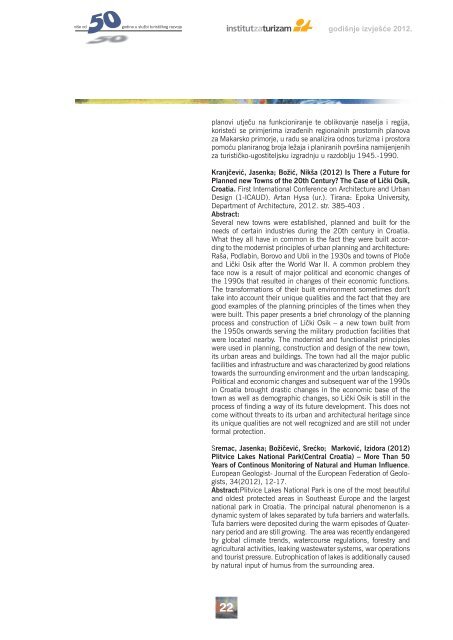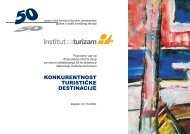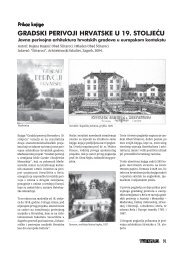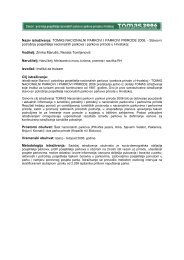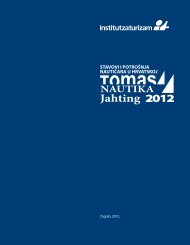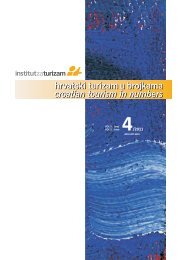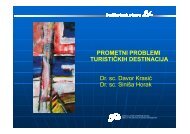više od godina u službi turističkog razvoja
IT godiÅ¡nje izvjeÅ¡Äe 2012 - Institut za turizam
IT godiÅ¡nje izvjeÅ¡Äe 2012 - Institut za turizam
You also want an ePaper? Increase the reach of your titles
YUMPU automatically turns print PDFs into web optimized ePapers that Google loves.
<strong>više</strong> <strong>od</strong>g<strong>od</strong>ina u <strong>službi</strong> <strong>turističkog</strong> <strong>razvoja</strong>g<strong>od</strong>išnje izvješće 2012.planovi utječu na funkcioniranje te oblikovanje naselja i regija,koristeći se primjerima izrađenih regionalnih prostornih planovaza Makarsko primorje, u radu se analizira <strong>od</strong>nos turizma i prostorapomoću planiranog broja ležaja i planiranih površina namijenjenihza turističko-ugostiteljsku izgradnju u razdoblju 1945.-1990.Kranjčević, Jasenka; Božić, Nikša (2012) Is There a Future forPlanned new Towns of the 20th Century? The Case of Lički Osik,Croatia. First International Conference on Architecture and UrbanDesign (1-ICAUD). Artan Hysa (ur.). Tirana: Epoka University,Department of Architecture, 2012. str. 385-403 .Abstract:Several new towns were established, planned and built for theneeds of certain industries during the 20th century in Croatia.What they all have in common is the fact they were built accordingto the m<strong>od</strong>ernist principles of urban planning and architecture:Raša, P<strong>od</strong>labin, Borovo and Ubli in the 1930s and towns of Pločeand Lički Osik after the World War II. A common problem theyface now is a result of major political and economic changes ofthe 1990s that resulted in changes of their economic functions.The transformations of their built environment sometimes don’ttake into account their unique qualities and the fact that they arego<strong>od</strong> examples of the planning principles of the times when theywere built. This paper presents a brief chronology of the planningprocess and construction of Lički Osik – a new town built fromthe 1950s onwards serving the military pr<strong>od</strong>uction facilities thatwere located nearby. The m<strong>od</strong>ernist and functionalist principleswere used in planning, construction and design of the new town,its urban areas and buildings. The town had all the major publicfacilities and infrastructure and was characterized by go<strong>od</strong> relationstowards the surrounding environment and the urban landscaping.Political and economic changes and subsequent war of the 1990sin Croatia brought drastic changes in the economic base of thetown as well as demographic changes, so Lički Osik is still in theprocess of finding a way of its future development. This does notcome without threats to its urban and architectural heritage sinceits unique qualities are not well recognized and are still not underformal protection.Sremac, Jasenka; Božičević, Srećko; Marković, Izidora (2012)Plitvice Lakes National Park(Central Croatia) – More Than 50Years of Continous Monitoring of Natural and Human Influence.European Geologist- Journal of the European Federation of Geologists,34(2012), 12-17.Abstract:Plitvice Lakes National Park is one of the most beautifuland oldest protected areas in Southeast Europe and the largestnational park in Croatia. The principal natural phenomenon is adynamic system of lakes separated by tufa barriers and waterfalls.Tufa barriers were deposited during the warm epis<strong>od</strong>es of Quaternaryperi<strong>od</strong> and are still growing. The area was recently endangeredby global climate trends, watercourse regulations, forestry andagricultural activities, leaking wastewater systems, war operationsand tourist pressure. Eutrophication of lakes is additionally causedby natural input of humus from the surrounding area.22


